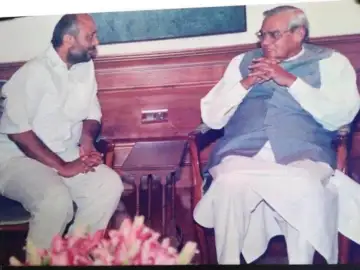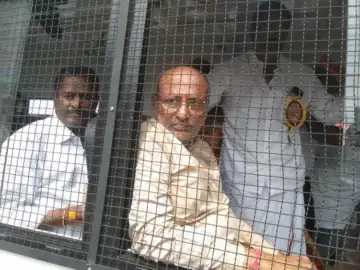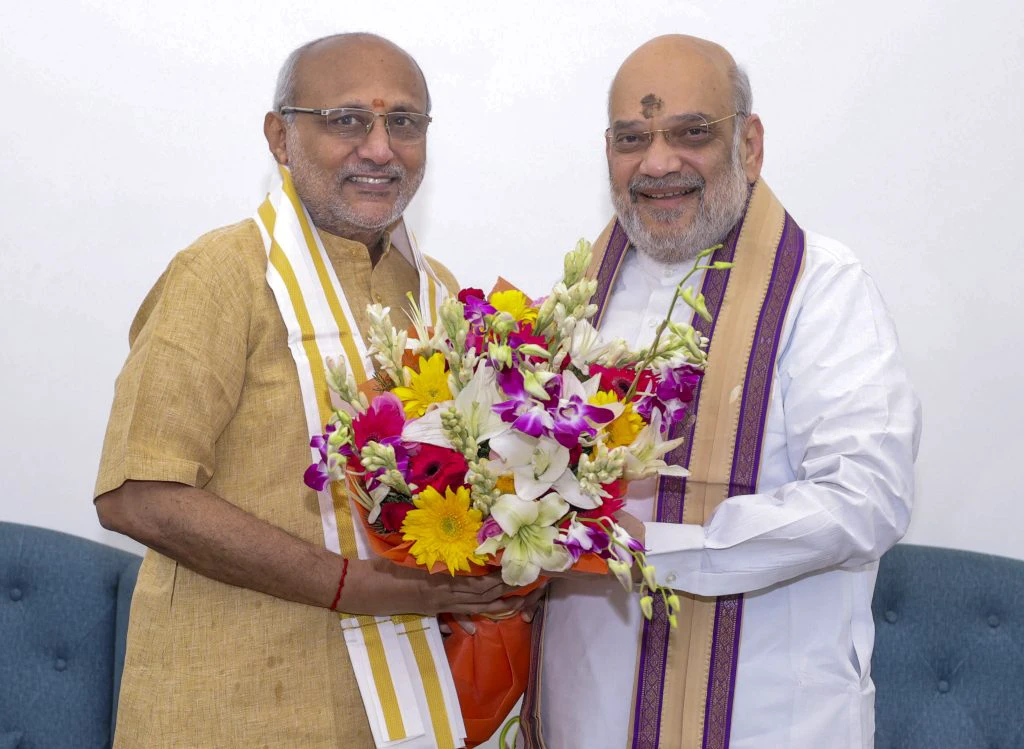Soon after the unceremonious exit of Jagdeep Dhankhar as vice president on the first day of the Parliament’s monsoon session, the Bharatiya Janata Party (BJP) parliamentary board meeting led by Prime Minister Narendra Modi came up with an unusual choice.
It nominated C.P. Radhakrishnan, Governor of Maharashtra, as the National Democratic Alliance’s (NDA’s) candidate for the vice presidential election.
The choice has already stirred conversations across political and regional spectrums. For many, the announcement is not merely about a reshuffle at the national level, but a calculated move in the battlefield of Tamil Nadu’s politics.
Chandrapuram Ponnusami Radhakrishnan, better known as CPR, is not just any governor moved into the spotlight. His roots are firmly in Tamil Nadu, his political journey inseparable from the BJP’s struggles and aspirations in the state.
Started political journey with RSS and Jana Sangh
Born on May 4, 1957, in Tiruppur, CPR holds a Bachelor’s degree in Business Administration. His political journey began with the Rashtriya Swayamsevak Sangh (RSS) as a Swayamsevak. He later became a state executive committee member of the Bharatiya Janasangh in 1974.
While CPR’s rise within the party ranks is indeed phenomenal, the BJP’s footprint in the state has remained limited and often inconsistent.
Observers say CPR’s candidature is more about symbolism and strategy. For years, the BJP has struggled to shed its image as an outsider in Tamil Nadu, a state where Dravidian politics dominates and Hindutva finds little fertile ground. In nominating a Tamil leader for the second highest constitutional office in the country, the BJP seems to be signalling two things at once: a recognition of Tamil Nadu’s importance in national politics and a message to Tamil voters that their leaders are not excluded from positions of prestige.
Leader after leader in the BJP and its allies have already begun to play up this narrative. That the BJP is “walking the talk” by elevating a Tamil voice to the vice presidency. But whether this symbolism will translate into electoral dividends is another question altogether. For one, both the Dravida Munnetra Kazhagam (DMK) and the Congress have rejected the idea of ‘Tamil’ leader for Vice President.
DMK MP Kanimozhi Karunanidhi and Congress MP from Tamil Nadu Manickam Tagore among others have pointed to the ‘RSS background of the Vice President candidate’ making a definitive case for ideology over identity.
CPR’s formal career in the BJP picked up momentum in 1996 when he was appointed secretary of the Tamil Nadu unit. Two years later, in 1998, came his defining political moment. That year, Coimbatore was rocked by serial bomb blasts in February, claiming 58 lives. The blasts polarised the electorate, consolidating Hindu votes against Muslims.
Instrumental in giving BJP its first significant breakthrough in Tamil Nadu
Riding this wave, CPR contested and won the Coimbatore Lok Sabha seat with a massive margin of 1,44,676 votes. This was not only his first electoral victory but also the BJP’s first significant breakthrough in Tamil Nadu.
He managed to retain the seat in 1999, becoming the only BJP leader from Tamil Nadu to have won two consecutive Lok Sabha elections. Along with two other MPs, his 1998 victory was celebrated within the party as a turning point. Yet the momentum proved difficult to sustain. CPR contested in the 2004, 2014, and 2019 Lok Sabha elections but ended up on the losing side each time.
 An old photo of C.P. Radhakrishnan, incumbent Governor of Maharashtra, and the National Democratic Alliance’s (NDA’s) candidate for the vice presidential election with former Prime Minister Atal Bihari Vajpayee. Photo: X.com@CPRGuv
An old photo of C.P. Radhakrishnan, incumbent Governor of Maharashtra, and the National Democratic Alliance’s (NDA’s) candidate for the vice presidential election with former Prime Minister Atal Bihari Vajpayee. Photo: X.com@CPRGuv
During his tenure as MP, CPR held several important positions. He chaired the parliamentary standing committee for textiles, served on the committees for public sector undertakings and finance, and was part of the special committee investigating the stock exchange scam.
His reach extended beyond national borders when, in 2004, he addressed the UN General Assembly as part of a Parliamentary Delegation. He was also a member of the first parliamentary delegation to Taiwan.
From 2003 to 2006, CPR served as the Tamil Nadu BJP state president. His tenure was marked by ambitious campaigns, including a 93-day, 19,000 km ‘Ratha Yatra’ that covered multiple issues: interlinking of rivers, the uniform civil code, anti-terrorism, eradication of untouchability, and the fight against drugs. Despite his energy and visibility, the electoral returns were disappointing.
The BJP, in alliance with the All India Anna Dravida Munnetra Kazhagam (AIADMK) in 2004, failed to win a single seat in Tamil Nadu. In 2006, contesting alone in 225 Assembly constituencies, the BJP once again drew a blank.
In elevating CPR, BJP is clearly considering the caste arithmetic too. He belongs to the Kongu Vellala Gounder community, numerically strong and politically influential in the Kongu belt of western Tamil Nadu. It is in this region that the BJP has managed to cultivate a presence, often riding on anti-DMK sentiment and the appeal of Prime Minister Narendra Modi among urban voters. By nominating CPR, the BJP hopes to consolidate this base further.
Nominating CPR is part of BJP’s larger strategy to woo voters in Tamil Nadu
This move also fits into home minister Amit Shah’s larger strategy. Earlier this year, he announced the BJP-AIADMK alliance, a full year ahead of the 2026 polls. Now, with a Tamil leader being fielded for the vice presidency, the party is carefully building a narrative of inclusion in Tamil Nadu’s political future.
Radhakrishnan’s ascent to the vice-presidential nomination should be viewed in the broader political context of the NDA versus the INDIA bloc. The opposition has chosen former Supreme Court judge B. Sudershan Reddy as its joint candidate.
While CPR’s candidature has its focus on political and caste issues, Reddy’s nomination emphasises credibility, judicial integrity, and the importance of having a respected legal figure in a constitutional position.
In this contest, the BJP appears to be less concerned about the outcome. The NDA numbers in Parliament essentially ensure CPR’s victory. Instead, the party is more focused on the story it can create around the nomination. Winning the vice presidency may seem certain, but the image in Tamil Nadu is what the party perhaps really wants.
It is also important to note that CPR’s rise has received recognition at the national level. Beyond Tamil Nadu, he has held several constitutional roles, including chairman of the Coir Board in Kochi, BJP in-charge for Kerala, Governor of Jharkhand, and later Maharashtra. At different times, he has also served as Governor of Telangana and Lieutenant Governor of Puducherry. These positions are a testimony to his reputation within the BJP as a trusted member, someone reliable in sensitive roles without controversies.
 C.P. Radhakrishnan being arrested on November 10, 2020, for conducting a public meeting in Tirupathur in violation of restrictions. Photo: X.com@CPRGuv
C.P. Radhakrishnan being arrested on November 10, 2020, for conducting a public meeting in Tirupathur in violation of restrictions. Photo: X.com@CPRGuv
By bringing CPR into the national spotlight as a vice-presidential nominee, the BJP is making a strategic decision. On the one hand, it strengthens the party’s claim of representing Tamil Nadu at the highest levels. On the other, it aims to leverage CPR’s caste identity and political background to rally support in the Kongu region ahead of 2026.
The risk lies in overestimating symbolism. Tamil Nadu’s electorate has a history of rejecting token gestures from Delhi, whether these come as cabinet posts or gubernatorial roles. The Dravidian parties have based their legitimacy on this skepticism – Tamil Nadu will not be swayed by positions in Delhi without real engagement with its needs.
Whether this move will signal a turning point for the BJP in Tamil Nadu or just another symbolic gesture will be tested not in the Rajya Sabha vote on September 9, 2025, but in the Assembly elections of 2026.
